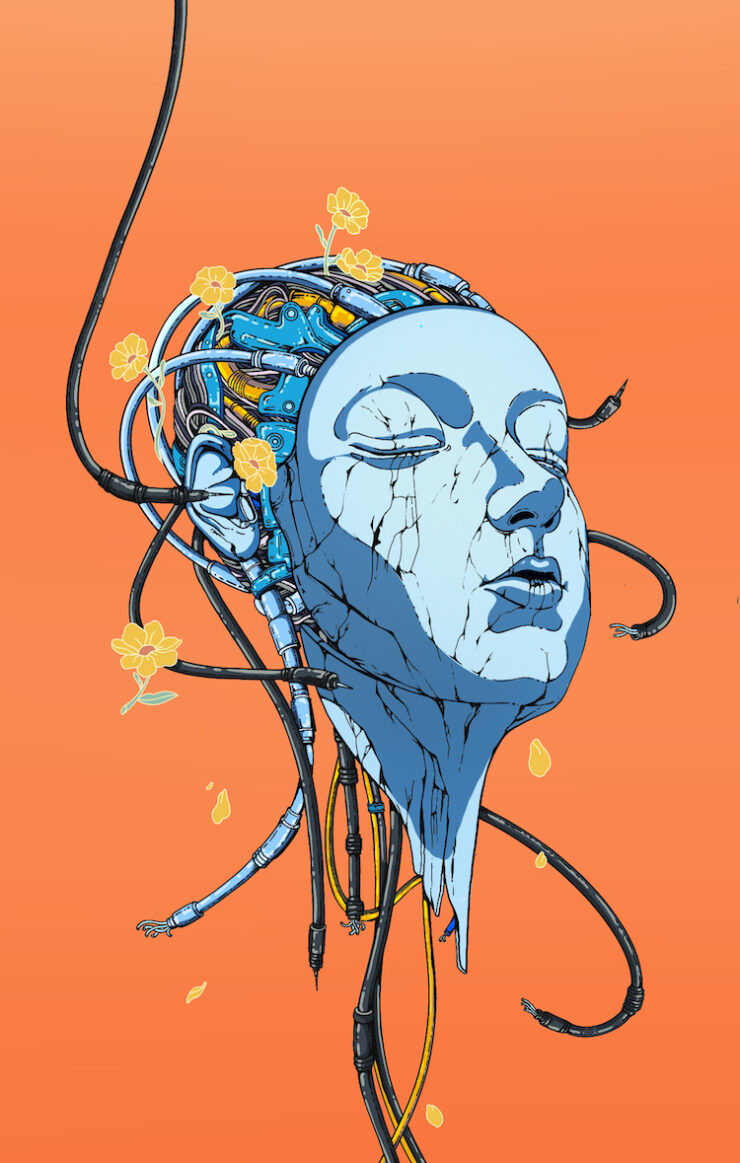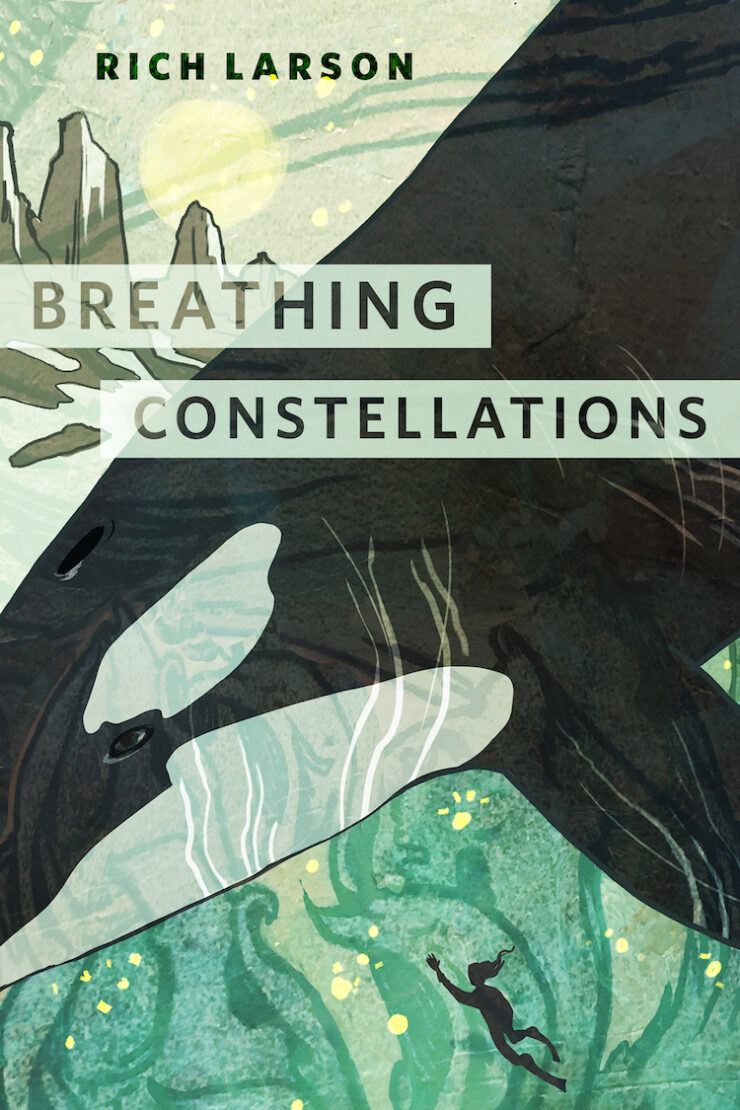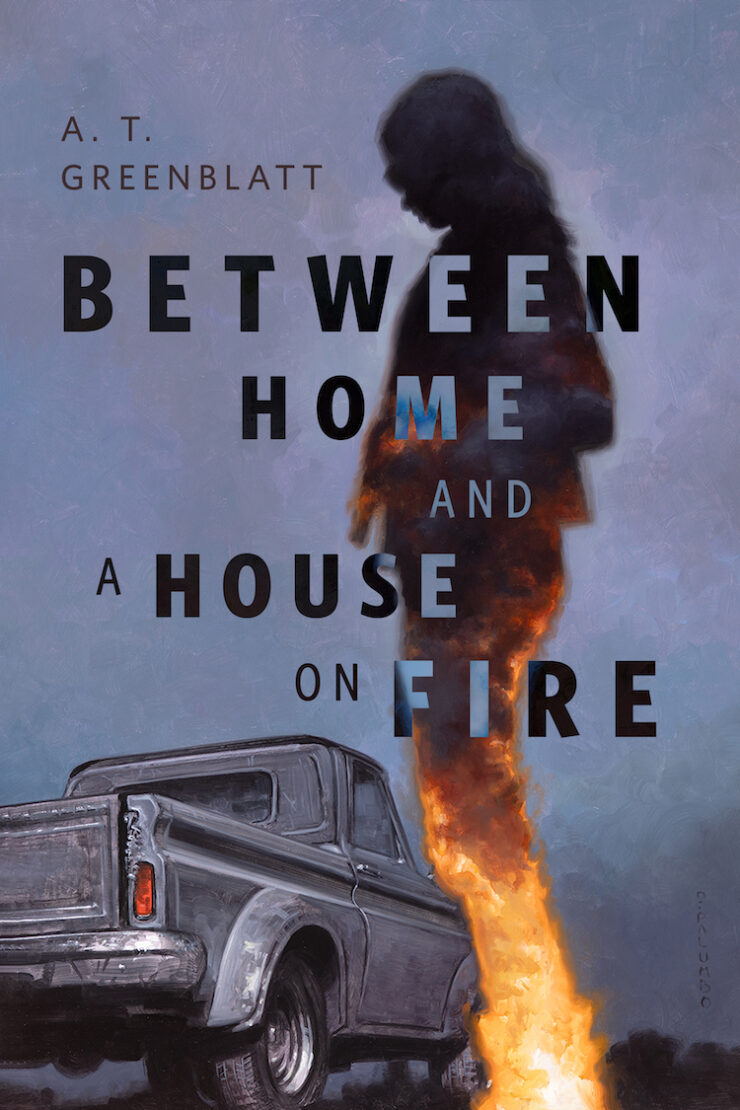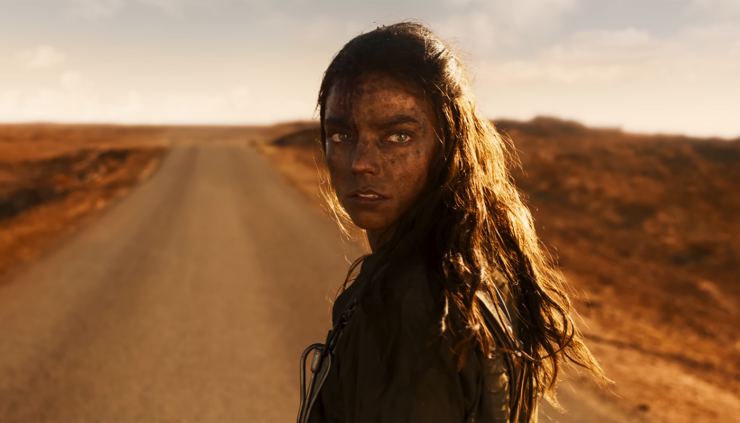Two hours in to Furiosa: A Mad Max Saga, we finally see a familiar version of the character we know from Mad Max: Fury Road. Furiosa (Anya Taylor-Joy) stands atop a dune, high above a warlord named Dementus (Chris Hemsworth) groveling in the dirt. Her hair is shaved close to her head; her forehead is coated in black engine grease. She uses a metallic prosthetic arm to pull down the scarf covering the lower half of her face. We recognize her as a vision of the character played by Charlize Theron in Fury Road. She’s become an icon, a symbol, and Dementus refers to her as such. As soon as he recognizes her, he calls her “you fabulous thing.” The use of the word “thing” is jarring: Furiosa’s allies will spend all of Fury Road insisting that people are not things.
Dementus’ choice of words fits the setting. The Wasteland of Furiosa: A Mad Max Saga is a utilitarian place. Nothing goes unused; every vehicle is cobbled together from the detritus of the old, dead world. The gas pedal of the War Rig locks in place using a Brannock device, which was invented to measure feet for shoes. The War Rig itself starts life as a shiny, massive machine with ornate decorations, shedding pieces with each road battle until it appears duller, a practical stripped-down machine with a second life made from spare parts. Spare tires are used as drags for kicking up dust, a protective measure that both blots out tire tracks and protects the biker from sniper fire. Discarded parts are recycled, over and over again, swapped in and out of increasingly strange configurations. In the Wasteland, every object is useful long after its original purpose has been forgotten.
The Wasteland reduces people to their most utilitarian purposes too. Road warriors and War Boys are useful to their leaders only as long as they can drive and fight. The apocalypse has made these people into things, and for the most part, Wasteland denizens don’t question their place. Everyone’s interchangeable, and everyone’s scrabbling for scraps of revenge in the desert. The History Man (George Shevtsov) acknowledges the fabric of his society when he describes the endless churn of war as “eyes for eyes, teeth for teeth, rage fueled by grief.” If you’ve been harmed, the only proper thing to do is to turn around and deal the same destruction back in kind. “An eye for an eye” is the ultimate utilitarian statement: you took something from me, so I’ll take some thing from you. It’s fitting that Furiosa, like the 1979 Mad Max before it, turns out to be a revenge movie in the end.
The first thing the marauders do when they take young Furiosa (Alyla Browne) from the Green Place is tie her to the back of a bike. The next thing they do is figuratively deny her her personhood: when she first arrives at their camp, her captor Toe Jam (David Field) refers to her as “it,” telling the other marauders to back off because “it’s mine.” Their leader Dementus puts on a polite face, telling one of his people to clean Furiosa up with their “best drinking water.” His politesse only functions as a way to try to get her to talk about where she’s from, in the hopes that he could take it for his own: another method of using a person as a tool. Furiosa is immediately made into a thing for Dementus to possess, muzzled and chained, like the dogs Dementus keeps.
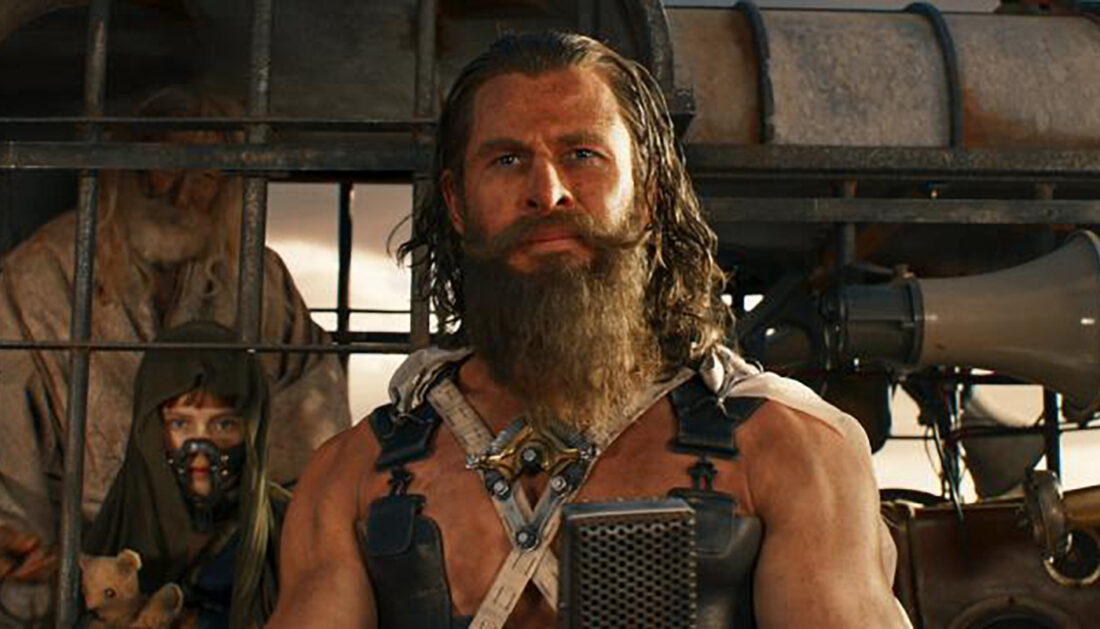
So much of the Wasteland turns on this ethos of ownership and possession. Immortan Joe’s (Lachy Hulme) War Boys are interchangeable cogs in his machine; any one of them will leap at the chance to die a glorious death and be taken to a hero’s afterlife, though they don’t know that Joe only instills this sense of fanaticism in order to maintain his grip on his corner of the Wasteland. They don’t need to be told that they’re objects who serve at the whims of the Immortan. The War Boys scarify machinery onto their skin: engine blocks, car parts, tools, guns, physical representations of the things they’ve become. Even their doctor, the Organic Mechanic (Angus Sampson), is named for his ability to fix human beings as though they’re cars, not people. The Organic Mechanic wields a knife more easily than he would a scalpel; he administers remedies made of human blood with the same care with which he might conduct an oil change. People’s bodies become interchangeable parts in the Immortan’s war machine.
This attitude is evident in Mad Max: Fury Road as well. When captured, Max (Tom Hardy) is discovered to be a universal donor full of “high-octane crazy blood.” The War Boys call him “blood bag,” as though he’s only a shell to protect the fluids he carries around in his body. The Five “Wives” (Rosie Huntington-Whitely, Riley Keough, Zoë Kravitz, Abbey Lee, and Courtney Eaton) are referred to by Immortan Joe’s (Hugh Keays-Byrne in Fury Road) people as his “prize breeders,” reduced to the state and functions of their wombs and ovaries. (Even the title “Five Wives” is a misnomer: it acknowledges the women as people, but it claims a level of consent that they were never granted in their situation.) Everyone in the Wasteland has been dehumanized in some way, and the ones who survive best are the ones who embrace that feral, lonely position. Rosie Huntington-Whitely’s character, the Splendid Angharad, dares to proclaim that “we are not things.” Her statement is stunning in its simplicity. It’s a four-word manifesto that rejects everything the warlords in the Wasteland stand for, while also asserting the worth and dignity of anyone who dares speak those words.
The new prequel makes Angharad’s manifesto retroactively even more radical. In Fury Road, it’s feasible that some characters may have chosen their lot; Nux (Nicholas Hoult) in particular seems to find a shred of individual identity in being a driver in Immortan Joe’s ranks. As Furiosa deepens the world of the Wasteland, it becomes apparent just how deeply sunk into their utilitarian non-identities everyone has become. Like the Organic Mechanic, many characters are named according to their usefulness on the War Rig: names like Pissboy and Black Thumb are common enough as to be considered unremarkable. In the Citadel, people are only as useful as their bodies and what they can do with them. Furiosa rises up the ranks because she’s small and nimble and fearless. As soon as she demonstrates her worth, she’s given the gloves of another Citadel denizen in a symbolic transfer of identity as well as power.
Dementus folds other Wasteland wanderers into his own ranks in a similar bloody fashion by forcing the members of their convoy to kill each other down to the last five, who must then in turn kill their old leader in order to join Dementus’ crew. Their old leader is literally dismembered, no longer a person but a rite of passage and a scattering of body parts. Dementus promises food and safety to anyone who joins him; the History Man tells Furiosa to make herself useful to Dementus, and he’ll provide for her. But usefulness in Dementus’ eyes is not a guarantee of safety. He’ll kill his own if he thinks it will give him an advantage on the battlefield.
The Green Place, or what little we see of it, isn’t quite so dystopian. It has solar power and wind power instead of oil and gasoline; it relies on cooperation with the movements of the earth rather than extractive mining of its resources. Unlike the marauders, who are as interchangeable as their bikes, the Vuvalini each have individual worth and dignity. When Furiosa is stolen, her mother Mary Jabassa (Charlee Fraser) chooses to go after her daughter alone, sending another woman back. Mary tells the other, “they need you here,” a recognition she is a unique and necessary part of a communal whole. We keep track of Furiosa as an individual—and as someone who’s maintained some semblance of humanity—because the movie tracks so closely to her silent, staring viewpoint, a silent individual caught up in the turn of the machine. She maintains her humanity through her intense stare, her need and her drive to escape, and the extraordinary lengths she goes to in order to go back home to the Green Place.
For so much of the movie, we spend our time at Furiosa’s eye level, watching as she grows up from a taciturn child to a wiry young adult (played by Anya Taylor-Joy). When she’s instructed to salute Immortan Joe, fingers interlaced above her head in the shape of a V-8 engine, she does so silently. The camera remains close to her face, her eyes dead center, speaking the determination and the hate that she cannot voice out loud. When she stows away on the War Rig, the camera finds her determined eyes blazing next to the whirling drive shaft. When Praetorian Jack (Tom Burke) discovers her, he sees her first as a person, eager to escape the life she’s been living in the wasteland. He offers her a place in his crew, and with it a chance to better learn how to survive the fighting in the wilderness. The two sit as equals in the front of the War Rig, impassive eyes forward, staring straight down the barrel of the camera.
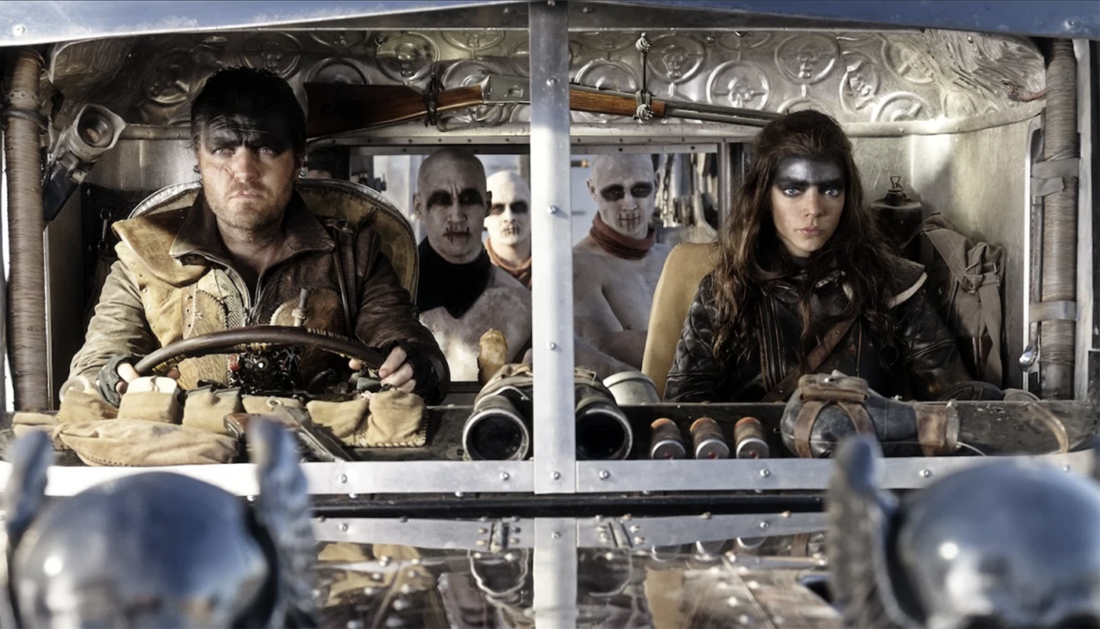
The steady eye-level view drifts away from Furiosa and Jack when they attempt to fight their way out of a trap set by Dementus. We see them from above like a bird would, as though their disembodied souls are watching their tiny car when it rolls over in a collision with a monster truck. We briefly return to the eye-level view while Dementus toys with his two prisoners. Furiosa and Jack lean up against each other, supporting each other; he’s winded and her arm is broken. They breathe heavily like wounded animals in a startling display of human vulnerability. But in the Wasteland, vulnerability gets people killed. Dementus murders Jack cruelly, forcing Furiosa to watch. She manages to break free, leaving her broken arm behind her like an animal who’s gnawed its leg off to escape a snare. After her escape, the camera remains at a remove, following her from below and above, but never exactly on her level. Something’s been knocked off-kilter. She always wanted to seek revenge—every time she sees Dementus before this point, it’s with a barely restrained trigger finger—but the final act turns to pursuit and revenge.
The Mad Max series has always been intrigued by the human death drive and the need for retribution. The original film—like Furiosa—takes the time to sit in the strange violence of its gritty, nearly-apocalyptic world until Max’s wife and child are murdered, kicking off the third act in which Max loses his sanity along with any inhibitions about taking bloody revenge. The rhythm of the final act of Mad Max, which frames Max’s V8 Interceptor like a silent panther in pursuit of the remnants of the biker gang, feels like a blueprint of Furiosa’s own hunt for Dementus and the last of his crew. The rest of the world falls apart between the 1979 Mad Max and its sequel, with the fallout from Mad Max mirrored by the fallout from nuclear radiation that now permeates the desert. The Road Warrior and Beyond Thunderdome detangle the eye-for-an-eye impulse that burned the world’s civilizations down, and that keeps Max Rockatansky himself at an arms-length remove from the rest of humanity; his thirst for revenge prevents him from returning fully to civilization, and he eventually leaves behind any community he joins.
Fury Road is, in Furiosa’s own words, an attempt to seek “redemption” after the fire and blood of doing war in the Wasteland. The older Furiosa of Fury Road, played by Charlize Theron, meets the camera’s gaze with the dead calm of someone who’s seen every horror under the sun. Miller’s camera, in return, remains locked at Furiosa’s eye level: somehow, despite her legendary status amongst the War Boys, and despite everything she’s had to do to survive, she’s managed to retain her humanity. The camera sees her as an equal, and also as a human. She clings to her personhood by telling Max that she’s on a quest for “redemption,” an acknowledgement that she’s done terrible things, and wants to make amends for them.
The prequel movie makes one fatal mistake. It raises Furiosa from her very human self into an icon, an object incapable of doing anything wrong because those who did it to her first had it coming. The Furiosa of Fury Road is an iconic figure in pop culture, but Fury Road never treats her as such; she’s interesting because of her humanity, not in spite of it. Furiosa treats the titular character’s final incarnation as a one-armed “dark angel” sent to deliver retribution, a force of will who’s somehow transcended her own humanity. She stands alone above everyone else, removed from her—and their—humanity. Dementus addresses her as “you fabulous thing.” The line, as it’s written, should be an indictment. It’s a recognition that Furiosa has managed to beat Dementus at his own cruel games, and he’s saluting her for it. But by referring to her as a “thing,” he’s also dehumanizing her in the way that the Wasteland manages to dehumanize everybody.
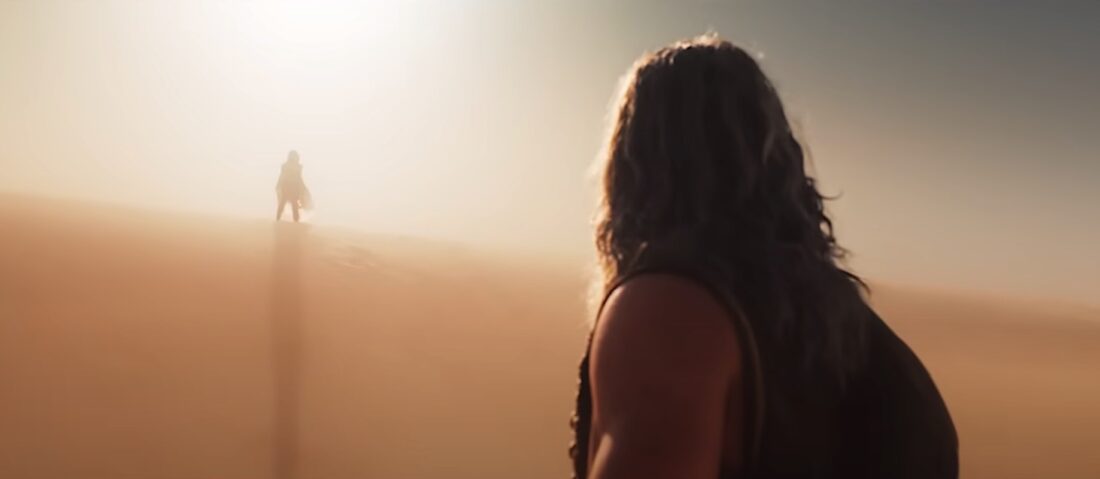
By the end of the film, Furiosa can’t be a person any more. She’s an object of pity, then fear, then awe, and the movie frames her as such, the camera gazing directly up at her pitiless face from an extreme low angle. The camera worships her as though she’s a goddess. Chris Hemsworth delivers the line of “you fabulous thing” with an attitude of awe. She’s the first person who’s managed to shake him loose of his own bone-deep rage and sadness, and to thank her for it, he calls her a thing. He’s been in the Wasteland too long. All he knows how to do, even when he’s paying tribute to someone, is to objectify them. For a moment, the movie slips, and in worshiping Furiosa as an icon the same way Dementus does, the film dehumanizes her as well.
Hope still grows on the margins of the Wasteland, despite everything. Fury Road remains in Furiosa’s future, still the culmination of a bleak examination of the fallout of violence and revenge. The radio transmissions that kick off Fury Road and Furiosa tell a story about people trapped in a cycle of use and violence, revenge writ large across the scale of history in the form of oil wars and nuclear retaliation. In Miller’s stories, revenge is just as destructive as a car accident, an act that cuts off any chance at building a new life and a new civilization. Dementus is so deep in his howling sadness that he tries to dig himself out with violence until, he admits to Furiosa, “too much is never enough.” He calls himself a dead man when they meet for the last time, the seed of petty revenge buried deep within his guts. He’s so far gone inside himself that he can’t fathom building something new with anyone else, and he almost takes Furiosa down with him. By contrast, Fury Road is a vision of a collective of women who refuse to be objectified, who invite Furiosa into their deeply human whole as they all seek to escape from the Wasteland. They assert their own humanity, and the humanity of others, insisting that there be no more killing, not even of War Boys. Only together can they find the last shreds of the Green Place, and to do so, they have to give up their instincts to kill, to take for themselves, to be lonely individuals. The version of Furiosa that Dementus declares to be a “fabulous thing” doesn’t need to be the version that survives. If she’s lucky, we’ll remember her as a person, too.


